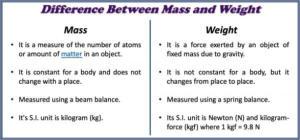Difference between mass and weight with example


Mass is the amount of matter that a body contains and weight is the action exerted by the force of gravity on the body. The mass of an object will always be the same, no matter where it is located. Instead, the weight of the object will vary according to the force of gravity acting on it.
Difference between mass and weight in Tabular form
| MASS | WEIGHT |
| Definition | |
| · The quantity of matter contained in a body is called it’s mass. · It is the measure of inertia in a body.
· It is that property of a body which determines the acceleration produced in a body under the influence of given force i.e. a =
| · Weight is the force with which earth attracts a body towards its Centre. · Weight is given by W = mg · |
| Characteristics | |
| The mass of a body remains constant ever where, whether it is measured at a point far the way from the center of the earth, or on the the surface at the Centre of the earth. | The weight of a body is not a constant quantity but its value is different at different places. |
| Quantity | |
| Mass is a scalar quantity | Weight is a vector quantity and is always directed towards the Centre of the earth. |
| Unit | |
| The S.I unit of the mass is the kilogram. | The S.I unit of weight is the newton. |
Mass and weight measurement
Weight is measured using a scale that effectively measures the force that Earth’s gravity exerts on mass. On the other hand, the mass of a body is measured by comparing it with another quantity of mass already known. The mass can be measured with a balance or a single pan scale. Measurement methods can vary, depending on whether the value of gravity is known and is constant, for example on Earth.
Effects of gravity on mass and weight
The weight of an object depends on gravity while the mass is constant regardless of the place and time where the object is. For example, if the mass of an object is 60 kilos, its weight would be 600 N (newtons). However, if it were weighed on the Moon, its weight would be 100 N since gravity on the Moon is 1/6 of what it is on Earth. The mass, on the other hand, will be the same in both situations. The mass is usually constant, the weight is usually not.
External factors that alter weight
Mass is the intrinsic measure of an object and is therefore independent of any external factor. Weight, on the other hand, depends on the mass that attracts it and the force with which it does so.
Mass and weight conversion
Newton’s second law is used to convert between mass and weight (force). The equation for calculating force is F = ma (force equals mass times acceleration). Force is exerted by gravity (weight), mass is that of the object in question, and acceleration is that caused by gravity. On Earth, this is 9.8m / s 2 .
Within this context, the same equation can be expressed in this way W = mg. W represents the weight, and g represents acceleration due to gravity.
Relative weight on the Earth, the Moon, and other planets
The following list lists the weights of a mass on the surface of some celestial bodies in the Solar System. It is worth mentioning that these quantities are relative to the weight on Earth:
- Weight in Mercury: 0.378
- Weight on Venus: 0.907
- Earth: 1
- On the Moon: 0.165
- On Mars: 0.377
- Weight on Jupiter: 2.364
- Weight on Saturn: 0.910
- On Uranus: 0.889
- On Neptune: 1,125
Uses of mass and weight
Within the physical sciences, the terms “mass” and “weight” are defined as measures that serve to apply precision and clarity. Its everyday uses, and since mass and weight are usually proportional on Earth, weight is used to describe both properties. However, its real meaning depends on the context. For example, in the commercial area, the “net weight” of products is really their mass expressed either in pounds or in kilograms. Instead, the tire load index, which specifies the maximum structural load for a tire in kilograms, refers to weight, that is, the applied force of gravity.